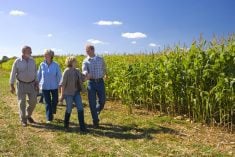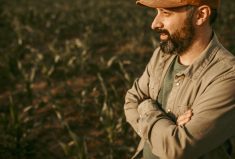Canada’s farmers are designing ever more creative business arrangements to deal with the scarcity of available land and with the capital requirements for farm expansion, diversification and succession. Now Saskatchewan producer Doyle Wiebe has developed and implemented a joint venture agreement on his farm near Langham, Sask., that may prove one of the most unique and also one of the most instructive.
With this joint venture, Wiebe Farms might even rival most marriages, with its combined attention to detail, its commitment to shared goals, and its focus on strategies for honest communication.
Read Also

Riding the tariff rollercoaster
Farmers are accustomed to roller-coaster years. But the current geopolitical windstorm is something else entirely. On his cattle operation near…
But there’s more. Designed to address his own succession needs, Wiebe’s approach also includes a system of returns for the joint venture partners that allows for flexibility in planning while ensuring not only his own financial security but the long-term viability of his young partner, Mark Thompson, and the future of the farm.
It’s working. Since the joint venture was implemented three years ago the farm has increased from 4,000 to 6,000 acres and added fababeans, lentils, soybeans and quinoa to the staple canola, wheat and feed barley rotation. Thompson was able to quit his job in nearby Saskatoon to farm full time, and Wiebe has stepped back and become more engaged in agricultural politics as he sits on the boards of SaskCanola, Canadian Canola Growers Association and Grain Growers of Canada.
This particular joint venture strategy came out of Wiebe’s meticulous research, put into motion with an ad on Kijiji.

The background
Wiebe farmed with his dad for 23 years until 1996, and only 15 of the years since have been full time. Another life in economics and business, plus stints volunteering abroad with his wife, artist/musician Valerie Wiebe, and their two sons, meant he used off-farm income for most of his farming years to add to a contributions-based return structure that was well ahead of its time. Father and son had a working agreement designed around their lives. When Doyle wasn’t there, his labour contribution decreased but he was paid a return on his portion of investment in land and equipment.
When his father was no longer actively farming, Wiebe farmed with an older employee willing to work the strange seasonal hours required on a Prairie grain farm. That employee left at about the same time Wiebe began to consider how he might ease out of the everyday demands of farming while maintaining a business interest.
Frustrated after three years of hiring annual summer help, Wiebe had an epiphany.
“I realized I was selecting people for their long-term potential,” Wiebe says. “So I thought, ‘why not just advertise for what I was looking for — a joint venture partner.’”
Which is what he did, placing an advertisement on Kijiji and telling his neighbours and members of the community what he was looking for. After numerous responses to the online ad, Wiebe screened the applicants for aptitude, commitment and like-mindedness in terms of what he calls “the essential principles of agricultural production.” When he thought he’d found the right person to partner with, they planned a non-binding “courtship” year which allowed either party to back out if things didn’t work out.
Well, they didn’t, and Wiebe wondered if he would end up simply pulling the pin. Unlike other areas, there is not a lot of demand for rent or purchase of land where he farms, but he has a number of landlords and puts great value on the relationships he’s cultivated with them. And his community is important to Wiebe. He didn’t want to leave anyone high and dry.
Then in 2013 Mark Thompson moved onto an acreage just down the road with his wife Kristin and their infant son. They had come from nearby Saskatoon where Kristin continues a career in architecture, and Mark worked in the pulse breeding program at the University of Saskatchewan Crop Development Centre.
Mark had grown up on a mixed cattle farm in the southeast, had a degree in agriculture with a minor in business, and wanted to farm.
“Not long after they moved in, I went over there and talked to Mark,” says Wiebe. “Within five minutes his eyes lit up. He could really conceive of the idea.”
Initially, Thompson kept his job and worked weekends, helping Wiebe with the 2013 harvest. Then the pair roughed out the courtship year as if Thompson was a full partner. By the fall of 2014 he was farming full time.
“I wanted to stay in farming, but knew I’d have to work at the same time,” says Thompson. “Once I met Doyle, I could walk away from my job and farm full time with way less risk to my family. I could make a career change without getting a PhD. It was a pretty easy decision.”
Nuts and bolts of the joint venture: The way contributions work
The sample spreadsheet (below) gives a clear picture of how the joint venture works.
Basically, it allows individuals to combine resources but retain ownership to create larger operations. It is based on three categories of “contributions” each party brings to the arrangement: labour, investment and depreciation.
“A dollar’s worth of labour is an annual contribution value,” says Wiebe. “A dollar’s worth of investment in land/equipment/buildings is only shown to have an annual contribution associated with a reasonable return on investment. We use five per cent. Depreciation is similar for depreciable assets. We use 12 per cent for equipment and four per cent on buildings.”
Each party shares a percentage of revenue and expenses based on their percentage contribution.
For the sample spreadsheet, there is a 60/40 split of contributions and income, although of course each joint venture would be different depending on individual numbers and the number of entities involved. The value for each of the contribution components is reassessed annually.
As this example indicates, one party may have considerably more invested in equipment and land, but may be contributing less labour as time goes on. As the percentages change, the incoming partner is provided greater opportunity to pay for the new capital contributions they are making.
This explains the beauty of the joint venture in succession planning.
In terms of accounting, the balance sheet for each party remains intact as long-term assets and debts remain with the individual parties. “Getting working capital into the joint venture is a little more tricky, accounting-wise,” says Wiebe. “But the most important aspect to get a good handle on is the cash versus accrued accounting that needs to happen each year after proper sharing of cash and accrued profits.”
According to an Alberta Agriculture report, Joint Ventures in Agriculture (revised Apr. 2017), the structure can be reasonably simple to administer, and is relatively easily dissolved at the end of an agreed to term (or, in a succession situation, when the original partner fully retires). It also has the added benefit of tax efficiency. Corporate entities in a formal partnership share the small business deduction threshold so whatever is earned above that number is taxed at a higher rate. But in a joint venture, income is allocated to the parties separately and therefore each entity can take advantage of the full small business deduction, meaning more of their income is taxed at the lower corporate rate.
While it might be simple in theory, the complexity of transitioning from a single balance sheet for his farm to accounting for the joint venture was a surprise to Wiebe, as was the discovery that professional accountants wouldn’t be of much help. Maybe that’s because while many farmers claim to be working within some sort of joint venture, true joint ventures are actually quite rare, according to Saskatoon-based farm management consultant John Spencer. Wiebe hired Spencer to help with the “soft” stuff related to the agreement.
A professional and forensic agrologist who’s worked in consulting for over 30 years, Spencer says everything about Wiebe’s joint venture is unique, adding that he’s used what he’s learned from Wiebe to help other clients. “Doyle’s books are in phenomenal shape. He’s inclined that way. And whatever he does, he does so well. He’ll worry a problem to death. He sinks his teeth in and chews until it’s solved.”
It took a lot of chewing.
Wiebe looked at other models of farm business including incorporation and simple family succession and didn’t like what he saw. He believes neither creates a sense of ownership as they are based solely on shares. In those models young farmers don’t have the opportunity to learn how to manage because they don’t grow into the business.

Case in point. In their first non-binding year, Thompson and Wiebe had a good crop with significant returns for each of them. But the first year of the formal joint venture was very poor. “The ups and downs were a good object lesson, a way to learn perspective and management,” Wiebe says. “I’m convinced of our model. If we’d have had a structured buy-out commitment, that poor first year would have changed everything immediately.”
He continues, “Mark is integrally involved in the impact of the decisions he makes. The model is not just about the numbers and making them viable, it’s also about making sure everyone understands the model. Your contribution according to the spreadsheet can be laid out and show that this much in means this much out… it’s easier to understand that buying a tractor affects my contribution and I can then take that to the bank.”
“The fundamental advantage of the joint venture is flexibility,” says Wiebe. “I know my numbers better than anyone. And we have a 10-year plan. But then you have a bad year or an exceptionally good year and it’s irrelevant. With the joint venture, every year we are responding to the resources available.”
Thompson agrees. “It took me a while to get my head around the joint venture, but after the first year of purchasing I could see how the contribution aspect worked. If I’d have been farming myself that first year, it would have been game over. But with the joint venture, the risk was shared and it wasn’t so bad. Doyle wanted to make it work so he carried over my losses and helped to weather the first year.”
The Alberta Agriculture report indicates that one of the critical components for a successful farming joint venture is the “development of a financial model that projects to the farmer what his individual bottom line will be in this new structure. This model has to answer the questions of whether the farmer will be better off financially through their involvement in the process.”
It’s pretty clear that both Wiebe and Thompson would agree that the answer in their case is yes. It’s also clear there is more going on in this relationship than what’s on paper. Their voices reveal a mutual respect and trust. Wiebe believes his young partner brings “brain trust” to the farm in his knowledge of pulse crops, and Wiebe’s experience has “knocked off five years of lessons and learning,” says Thompson.
While they have drawn up a legal document outlining the particulars of the joint venture for operating and Revenue Canada purposes, “there were no lawyers involved from my end,” Wiebe says. “If we can’t operate under these terms then we won’t do it. It’s a real human endeavour.”
“It works because we have the same goals and point of view on farming,” Thompson says. “The legal document ties us to each other and now we’re far enough into it, there’s incentive for both of us to make it work. It’s a symbiotic relationship.”
Making it work: The ‘soft’ stuff
“I’ve known Doyle a long time, and I thought he was crazy at first,” says John Spencer, back at Spencer and Associates. “You’re kidding right? You’re going to just pull some stranger in? But I’ve learned a lot about joint ventures by helping with this one. With Doyle you know the material will be exhaustively researched.”
While the joint venture operating agreement spells out the legal structure, contributions, accounting, etc., perhaps the most important part to Spencer is the communication plan.

He pushes such “soft skills,” insisting they are required to make any farm business arrangement work, whether it’s between family members, corporate interests or joint venture partners.
“Before you plan anything like budgets or cropping plans, you have to look at life plans,” Spencer says. In the case of this joint venture, he sat down with them individually, with the couples, with the wives, and hashed out their short- and long-term goals. Each was asked to outline what they value in themselves and the things they do, and to then make those values and goals the basis of the farm plan.
“If you don’t include everyone in the planning, then eight out of 10 times the plan will fail,” Spencer says.
Both Kristin and Val are “city girls” with their own businesses and interests outside the farm, but they needed to be involved in the planning to ensure their goals are realized and their needs met. And Mark Thompson is determined to spend family time with his wife and growing boys.
“The biggest stretch for me is to balance the family time with growing the joint venture to what I want it to be,” Thompson says. And he’s ambitious. “My goal is to have the equipment and people in place to maximize our 6,000 acres. I’m looking to reach 7,000 acres and run with two combines. That will give us a little wiggle room.”
While Wiebe has watched Thompson taking over more of the operations, maintenance and human resource management, he admits it hasn’t necessarily been easy to let go. And perhaps that’s where personality comes into the success of a joint venture designed for succession: the older partner has to let go.
“The difficult piece for farmers is to allow themselves to see another way of doing things,” Wiebe says.
“At first I missed running the tractor, but I’m getting used to coming home to find things moved around when I hadn’t asked anyone to move them,” he laughs. “My stress level is way down… and it feels good when you make a plan and it works, to have the feeling that I’ve made the right decision.”
Spencer credits the personalities of the two men, plus a good communication plan and a conflict resolution process for the early success of their agreement and seems convinced this joint venture will succeed.
“The key thing, and what is so cool, is this was a crafted decision,” Spencer says. “They built something that will work for them, is individual to them. They took the time and resources to come up with a solution to their situation. They built it to meet their needs.”
As the size of farms increases and as machinery costs climb, Spencer believes we will see more operating agreements between corporate entities, with the joint venture providing potential to create effective scale.
The joint venture dreamt up by Doyle Wiebe and enthusiastically embraced by Mark Thompson is a significant achievement and provides an example that can work for both family and non-family succession. It might also be an example of what can be done in the larger context of farm business structures to address diversification and economies of scale. And it all started with best laid plans, and an ad on Kijiji.
















